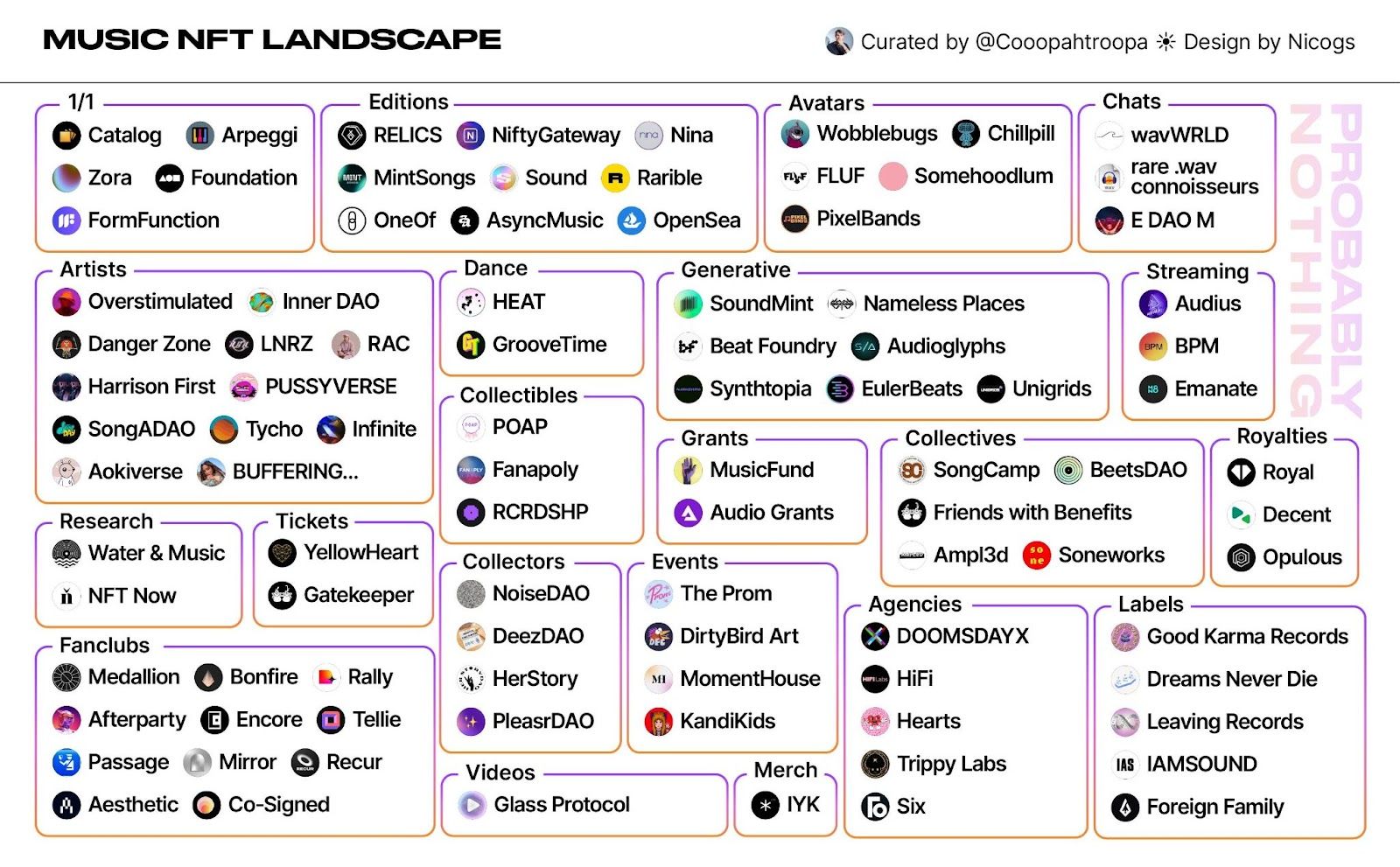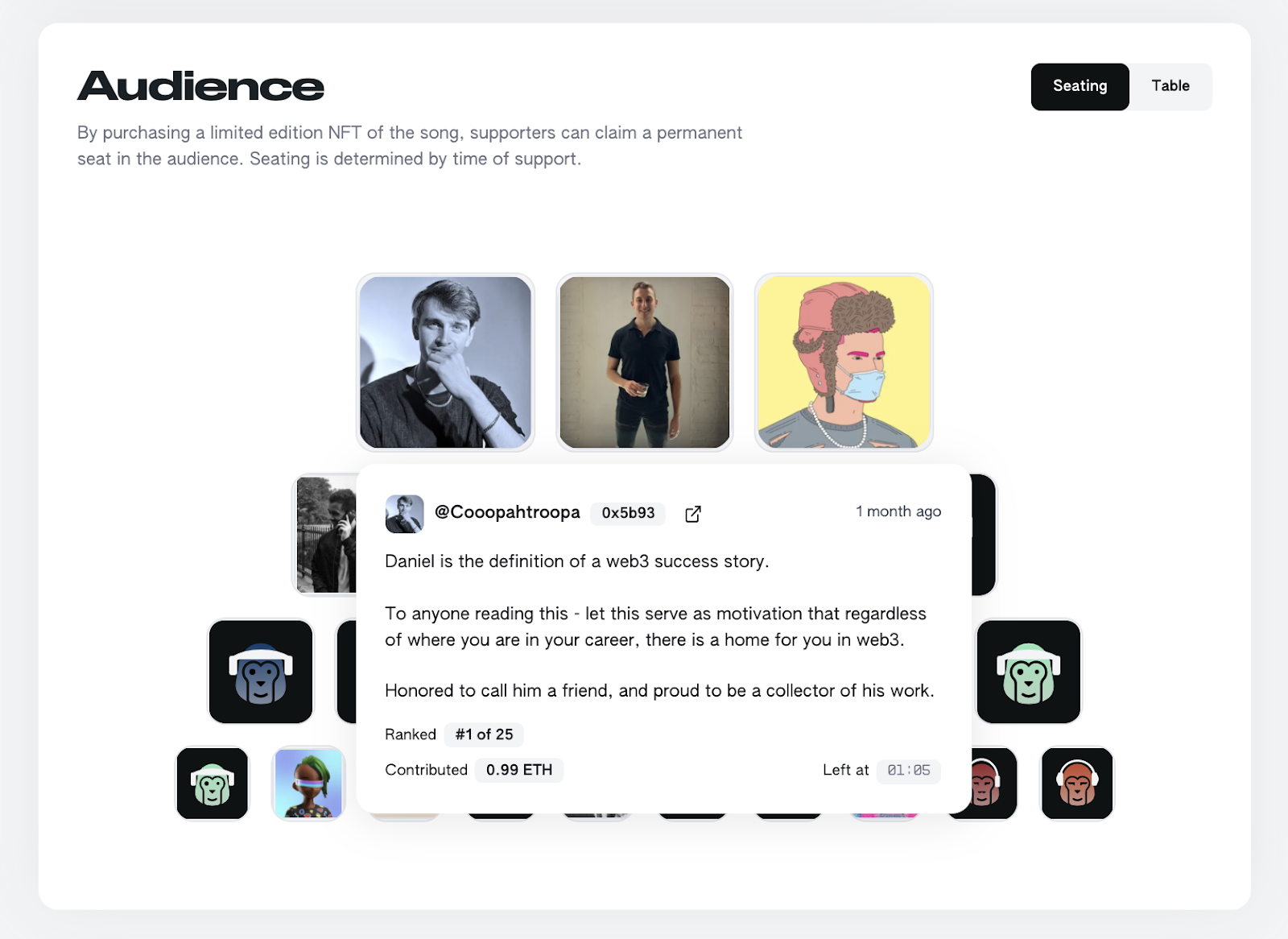The next big trend in NFTs

Dear Bankless Nation,
In 2021, it felt like the world became saturated with art NFTs.
Creators realized they could connect directly to their most avid fans instead of relying on intermediaries that extracted massive amounts of value from their hard work.
In its current evolution, that’s what NFTs stand for: A direct line between creator and fan, leading to a stronger relationship between value created and value captured.
But we’ve only seen NFTs explode in the art world. There are creators all over the world: Writers, musicians, videographers, designers, artists, etc.
All of them stand to benefit from digital ownership and NFTs.
We’ve seen some of these platforms take off, like Mirror Protocol for writers, but much of this potential is still unrealized.
Today, Lucas and Cooper give us a behind-the-scenes look into one of these untapped creator verticals and into the world of Music NFTs.
- RSA
Bankless Writers: Coopahtroopa, Operator in the Creator Economy & Lucas Campbell, Editor for Bankless.
There’s a new sector in NFTs emerging. One that poses the biggest potential for mainstream adoption yet.
Music NFTs are collectible audio files.
They give fans the opportunity to collect the songs they love, now with digital scarcity thanks to web3.
Collecting music is not new, but collecting music online is.
In the same way that we collect vinyl, burn CDs or make playlists, Music NFTs offer a new medium to curate your taste with exposure to the underlying creative work and its creator. In the traditional world, music collectibles represent north of a $5B market. In the digital world, the sky's the limit.
In this article, we’ll explore the rising trend in Music NFTs, and take a closer look at this new model for the next generation of independent artists.
A New Monetization Model
Music NFTs are a new monetization model for artists.
At its core, Music NFTs are simply digital collectibles. They carry no inherent ownership rights and merely exist as an asset that can be bought and sold by a collector.
In a world largely dominated by streaming and touring, Music NFTs offer artists leverage by building a community of superfans eager to collect scarce digital representations of the work.
There are platforms like Royal exploring Music NFTs with royalty rights, but for this article, we’ll strictly focus on Music NFTs as collectibles.
Collectibles offer the most direct and simple monetization mechanism given the lack of regulatory hurdles incurred when the artists own 100% of their rights.
For those unfamiliar, traditional streaming platforms like Spotify pay ~$3,700 per million streams.
In contrast, Music NFTs are selling for thousands of dollars - posing a strong argument that building community in web3 is more advantageous than playing the numbers game on Spotify.
While Music NFT sales can be largely dependent on the macro state of crypto, the benefits of a dedicated collector base of superfans holds true in any market condition. It is the direct monetization model to tap into an artist’s 100 true fans.
You don’t need to be a pop star to make a living - Music NFTs allow you to maximize your earnings potential with only a few dedicated fans. They are the bedrock of Creator DAOs and the first step towards music micro-economies.
I wrote about Music NFTs in-depth in this post, summarized with a broad layout of the current landscape for those unaware.

Zooming in, there are a couple of platforms currently leading the Music NFT charge.
These platforms pose the first real instances of how crypto might fix the music industry.
Catalog
Catalog is a 1/1 Music NFT marketplace.
Similar to SuperRare or Foundation, all NFTs are minted as 1/1 works - meaning no other copy of that song will ever be minted (in theory). Built on the Zora protocol, Catalog was the first marketplace to be designed specifically for collecting audio.
To date, Catalog has had over $2M+ in sales volume, with an average sale price of $3,707.
Here’s a look at the top-selling artists on Catalog and how it compares to their estimated Spotify earnings based on the $3,700 per million streams (or $0.0037 per stream).

On average, top web3 artists have earned 7.5x more from selling Music NFTs than their estimated earnings from a year’s worth of Spotify streams.
This makes the case clear: independent artists can earn substantially more through Music NFTs than streaming. Just as important, this is entirely additive–selling Music NFT does not take away from your streaming earnings.
On a broad scale, the average Catalog sale is currently translating to roughly a million streams on Spotify. With no underlying platform fee, 100% of that sale goes back to the creator.
But these sales are just getting started. Catalog is starting to experience hockey stick growth, with monthly sales squarely in the six-figure range and the average sale price trending upwards. Compared to SuperRare’s 1/1 art marketplace sitting in the eight-figure range, there’s plenty of room to run for Catalog and 1/1 Music NFTs.

Sound
Sound is a Music NFT marketplace that offers editions rather than 1/1s.
Each release features a Listening Party in which collectors listen to the full track, and then proceed to collect an NFT with the ability to leave a comment on the track.
Collectors are featured in an Audience tab - giving them a spotlight and the right to be featured for being early. When a Sound NFT is sold on the secondary market, so too does the rights to that comment slot.

With 30 consecutive sellouts, all Sound NFTs have been priced at a base rate of 0.1 ETH. This translates to each Sound NFT representing 75,000 Spotify streams and each sellout worth over 1.8M total streams at the standard 25 editions.
It’s also worth highlighting that Daniel Allan launched a 100 edition drop for his EP Overstimulated, selling out all of them in a minute and bringing in 10 ETH in revenue. For reference, the newly released EP has only generated $444 so far in estimated earnings from Spotify.

Lower price points leave more room for secondary market activity, offering the first glimpse into why drops have become such a Schelling Point for new collectors.
In addition to the primary sales, secondary volumes have been rising and generating increasingly more revenue for each artist. The average Sound.xyz drop generates roughly 420,000 streams worth of revenue in royalties alone.

Key Takeaways
One fan collecting a Music NFTs is virtually 100x more valuable than a monthly listener on Spotify. On average:
- 1 Catalog NFT = 1,000,000+ streams
- 1 Sound NFT = 2,500,000+ streams
This goes to show the leverage that Music NFTs have as a monetization model for independent artists. It allows collectors to value their work today, without banking on a hit song and waiting for the streaming fees to roll in. If it’s good music, collectors will buy it for what they think it’s worth.
Music NFT volumes are increasing, the total number of unique artists minting NFTs is increasing, and the number of unique collectors is increasing. But it’s still minuscule relative to the rest of the NFT market.
Music NFTs are due for their big break.
Looking at last month's volume, Catalog and Sound’s combined for less than $1M in primary and secondary sales, accounting for only 0.015% of OpenSea’s NFT volume.
You decide if that variable is one worth acting on.
Double Life
For artists releasing Music NFTs, you need to cater to both sides.
While web3 artists are seeing financial success, having a growing footprint in web2 is as important as well.
Web3 allows you to focus on the quality of your fan. Web2 allows you to focus on the quantity of your fans.
This relationship to convert a new web2 fan into a new web3 collector is the single biggest opportunity independent artists have today.
As time goes on, expect more artists to explore what it means to be web3-native, and for tracks to be released only as Music NFTs that are never distributed to DSPs like Spotify or Apple Music.
What to Watch For
For those keeping up with the Music NFT Landscape, here are some key platforms worth keeping an eye on in the coming weeks.
- Royal sold out its first drop with Nas.
- Monstercat’s new Music NFT project - Relics - debuts on February 4th .
- Arpeggi Season One mint passes are available for 0.6 ETH.
- DoomsdayX partnered with Haleek Maul to release 200 ETH worth of Music NFT producer passes.
- Glass Protocol is partnering with artists to release music videos as collectible NFTs.
- Omgkirby sold out their genesis NFTs for a community-led LoFi project.
To keep up with trends and research regarding Music NFTs, keep a close eye on Water & Music and NFTNow.
There’s a great research report on Music NFTs here and a recap of the top moments in Music NFTs from 2021 here.
Looking Ahead
Imagine being able to bet on your favorite artist early in their career.
With Music NFTs, this future is not far off.
While today we are exploring the means to collect music, it’s inevitable that this cycle leads into a full-fledged DAO economy in which artists are routing a percentage of all sales to a community-lead treasury.
And if you haven’t picked up on it yet, community treasuries usually lead to tokens.
Looking at early examples like Daniel Allan and his Overstimulated EP as a case study, we should all expect to see many more Artist DAOs in the near future.
Until then, give those Music NFTs as spin and start collecting.
This sector’s hidden gems are right in front of you.
Action steps
- 🎓 Learn how to get started with Music NFTs
- 🗺️ Explore the Music NFT Landscape
- 🎵 Check out Catalog and Sound